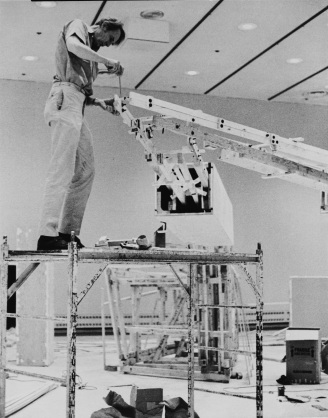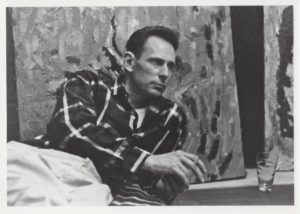1918 – 1936
Charles Ronald Wells Bladen was born on 13 July 1918 as the son of British immigrants in the Canadian city of Vancouver. After the daughter, Kathleen, he is the family’s second child. His father, Kenneth Bladen, was responsible for building up several steelworkers in Vancouver before working later as an expert in landscape gardening. His mother, Muriel Beatrice Tylecote, had studied at the Sorbonne in Paris and, as an active socialist, had taken part in the suffragette movement. Both parents later supported their son’s artistic interests.
The family moved several times within a relatively short period: in 1922 to the United States, to Hoquiam in Washington, and in 1926 to Aberdeen in the same state. In 1932, the family returned to Canada, living in Victoria British Columbia.
Already at the age of ten, Bladen was drawing intensively, making copies of works by Botticelli Titian, Picasso and Matisse, and creating free illustrations of Greek mythology. His talent was furthered in Aberdeen through participation in art courses at the high school while he was a pupil at junior high, and in Victoria through private art lessons given by the painter, Max Maynard. Apart from that, the young Bladen was enthusiastic about the sport, became a passionate dancer and baseball player, taking part also in tennis tournaments.
1937-1945
In 1937, Bladen began his studies at the Vancouver School of Art and continued them in 1938 to 1939, he attended additional courses in the figure study class of the painter, Allen Edwards.
In 1939, Bladen moved to San Francisco to continue his studies where, in the same year, he met the Mexican painter Diego Rivera, who was working on a large wall-painting commission. Up until 1943, Bladen studied painting and sculpture at the California School of Fine Arts, later renamed the San Francisco Art Institute, and attended evening courses at this school until 1945.
In 1941, when drafted into the Army, he was declared unfit for military service and obliged to work as a ship’s welder at the naval dockyards in Sausalito, California. For many years, this activity enabled him to earn his living as a toolmaker. This handicraft and aesthetic experience were to become important later on when constructing his sculptures.
Within a circle of friends, Bladen developed a growing interest in contemporary art, literature, music, and philosophy. He wrote poems, spent a lot of time in natural surroundings and experimented artistically with earth and plants that later lead on to a series of drawings, the Earth Drawings, which, together with the poems by Allen Ginsberg, he later published in the journal, The Ark. His spiritually and existentially oriented thinking led him to engage with East Asian philosophy.
Bladen had close contact with several writers and in 1945 joined the Libertarian Circle, a group of anarcho-pacifist artists around the writer, Kenneth Rexroth.
Bladen remained in the United States where, with interruptions, he lived in San Francisco until 1956 and then moved to New York.
1946 – 1955
In 1946, Bladen had his first solo exhibition at the Vancouver Art Gallery. At the same time, he was awarded a scholarship by the San Francisco Art Association which enabled him to undertake an eight-week journey to Tijuana in Mexico and New Orleans from June to August, as well as a stay of several months in New York until March 1947. There, in Peggy Guggenheim’s Gallery, he saw an exhibition with works by Jackson Pollock.
Within the Libertarian Circle, together with James Harmon, Philip Lamantia, Thomas Parkinson, Kenneth Rexroth, Sanders Russell, and Robert Stock, he founded the literary journal, The Ark, in 1947. Bladen designed the cover and made contributions in the form of drawings and linocuts.
In 1948, he met the actress Barbara Gross, whom he married a year later. Their son, Bran, born 1951, died shortly after of a kidney failure. The couple moved to San Carlos in California, buying a house on Winding Bay where Bladen set up a studio.
In 1951, Ronald Bladen was naturalized as a US citizen.
In 1955, he separated from his wife, Barbara Gross. Through his friend, Kenneth Rexroth, he got to know the poet, Michael McClure, at the end of the summer and moved back to San Francisco into McClure’s communal household with Joanna McClure, James and Beverly Harmon, Price Dunn and Larry Jordan. At this time a friendship arose with the writers, Allen Ginsberg, Jack Kerouac, and Henry Miller, as well as the painter, Al Held, who advised him to move to New York.
1956 – 1975
 In 1956, Bladen moved to New York where he lived on Houston Street. Through Al Held, he got to know painters, George Sugarman and Nicholas and John Krushenick, who together founded the Brata Gallery co-operative in 1957.
In 1956, Bladen moved to New York where he lived on Houston Street. Through Al Held, he got to know painters, George Sugarman and Nicholas and John Krushenick, who together founded the Brata Gallery co-operative in 1957.
Bladen continued to be active mainly as a painter. He made paintings in the style of Abstract Expressionism in which intensively colored patches of organic formations are integrated into almost landscape-like surface forms, similar in color.
In 1960, he took over Al Held studio a 5 West 21st Street, progressively restricted his painterly activity and began to occupy himself with collages made of folded paper and the first painted reliefs of plywood. As in previous years, to earn his living, he worked as a toolmaker.
In 1962, he exhibited his painted plywood reliefs for the first time at the Brata Gallery and the Green Gallery in New York. The following year he made his first free-standing, colored sculptures from plywood boards with metal struts. From this time on the Bladen dedicated himself exclusively to sculpture.
In 1964, he showed his first sculpture, White Z, at an exhibition in the Park Place Gallery in New York and got to know the sculptures, Connie Reyes, who later became his companion. He was awarded the National Medal of Arts by the National Endowment of the Arts. The first works include also Rambler, 1963/1964, and the Rockers, 1965, which Bladen understood as the artistic basis for all his further sculptures.
From 1956 on, Bladen enjoyed the growing attention of the New York art scene and beyond, so that subsequently he was represented with his austere sculptures, developed from geometric forms, at many famous exhibitions. His artistic stance, influenced by European Constructivism, American Hard-Edge Painting, and sculptures such as Isamu Noguchi and David Smith, in turn, had stimulating effect on a circle of younger artists including Carl Andre, Donald Judd, Sol LeWitt and Lawrence Weiner, who repeatedly called him the ‘father figure’ of Minimal Art.
In 1966, he showed a tripartite work made the previous year, Three Elements, at the exhibition, Primary Structures Younger American and British Artists, in the Jewish Museum in New York. This exhibition was very important for Minimal Art because it enabled a broader public to become acquainted with this new art movement for the first time. Together with other artists represented there, such as Carl Andre, Dan Flavin, Donald Judd, Sol Le Witt, Walter De Maria, Robert Morris, Tony Smith and Robert Smithson, since then Bladen has been assigned to this group working with an elementary frugality of forms, even though his conception, aiming at whole and the expressive power of the individual work, is distinguished from the serial and consistently matter-of-fact manner of artistic shaping and forming pursued by most of the other artists. This holds in a similar way for his sculptor- friends, Robert Grosvenor.
In 1967, at the Scale as Content exhibition in the Corcoran Gallery of Art in Washington, which brought together exclusively large sculptures by Bladen, Newman and Tony Smith, he showed his monumental sculpture, The X. set up in the hall, in the immediate neighborhood of Barnett Newman’s Broken Obelisk, which was positioned outside.
Bladen had his first solo exhibition as a sculptor in Hempstead, New York state, and was represented at a series of further groups exhibitions including also the show, American Sculptures of the Sixties, at the Los Angeles County Museum of Art. Articles appeared in several periodicals on his work, his position within contemporary sculpture along with extended interviews with him. On the basis of this positive resonance and associated purchases, Bladen was now able to devote himself exclusively to art. On the side, he taught at Hunter College in New York. Black Triangles arose between 1966 and 1967.
In 1968, Bladen was awarded the John Simon Guggenheim Memorial Foundation Fellowship, was represented at documenta 4 in Kassel, and was among the circle of artists presented to a European art public under the title, Minimal Art, West Berlin. He created Barricadeand a second version of Rockers, followed by Untitled (Curve) in 1969, Coltrane on 1970 and Boomerang in 1972.
At the beginning of the 1960s interest was growing in the United States in sculptures in public spaces. This turns toward ‘landmark signs’ and the clear, strongly expressive tectonics of Bladen’s works led him to receive numerous commissions from 1967 on. Thus The Cathedral Evening came about in 1969 for the Albany (New York), Vroom Sh-Sh-Sh in 1974 for Buffalo (New York), and Raiko I in 1975 for Galerie Schmela in Düsseldorf.
Since the mid-1960’s, Bladen’s works were represented by the Fischback Gallery in New York, Through its gallery director, Aladar Marberer, in 1973, he got to know the younger artist Bill Jenson, with whom he had a close friendship from then on. From 1974 to 1976, Bladen taught ass a guest lecturer at Columbia University in New York and was awarded the Mark Rothko Fellowship in 1975.
1976 – 1988
In 1976, Bladen was appointed teacher at the Parsons School of Fine Art, a post he held until 1978. An exchange with students gained generally in importance for him. He, therefore, accepted further teaching jobs, such as Artist in Residence in 1981/1982 at the Skowhegan School of Painting and Sculpture (Maine), and in 1982.1983 as a guest lecturer at Yale University in New Haven (Connecticut). In 1977, he was once again awarded the National Endowment of the Arts.
Bladen was mostly occupied with commissions which, since the 1970s, were often accompanied by preparatory models. Thus, in 1976, he created Cosmic Seed for Des Moines (Iowa), 1977, he created Kama Sutra for Central Park in New York, 1978 Oracle’s Vision for Springfield (Ohio), Black Lightning 1981 for Seattle and the campus of King Faisal University in Riyadh as well as Host of the Ellipse for Baltimore (Maryland). From 1985 on, the sculptor, Larry Deyab, assisted him in his work.
At the beginning of 1988, as recognition for his services to the summer academy in Skowhegan, Bladen was awarded the Skowhegan Trustees & Governor Award for Service to the Arts.